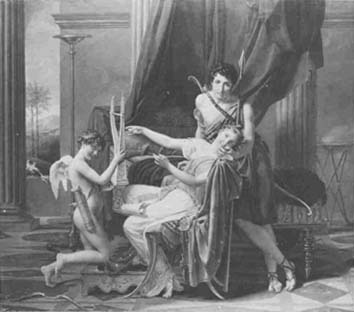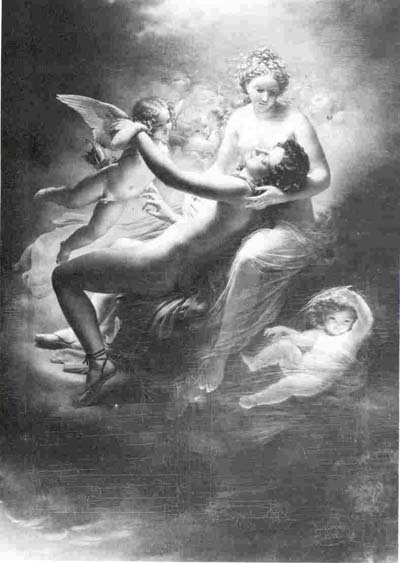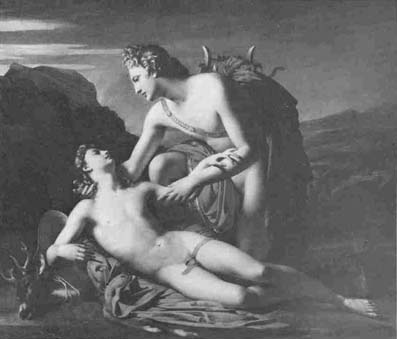
Annual Bulletin 2, 1978-1979
Home
Français
Introduction
History
Annual Index
Author &
Subject
Credits
Contact




Bacchus and Ariadne, by
Antoine-Jean Gros
by Thomas W. Gaehtgens
Pages 1
| 2 | 3
| 4
| 5
| 6
The artistic inspiration for the work came, to a large extent, from the
teaching that Gros received from David, whose influences on Gros increased
greatly during the last decades of Gros' life. In 1809 David had painted for
Prince Youssoupoff his Sappo and Phaon (fig. 6), a mythological love
scene in the style of the Empire; he continued to develop this theme in Cupidand Psyche (1817; Cleveland) and in
Mars Disarmed by Venus and
the Three Graces (1824; Brussels, Royal Museum), which was painted later
than Gros's work. (18) With these paintings, David put heroic history themes
aside and followed his earlier attempt, in 1788 with Paris and Helen
(Louvre), to represent mythological subjects in a contemporary setting, using
as far as possible accurate archaeological reconstructions. "David tries to
make his mythological heroes look like everyday people," is how Antoine
Schnapper put it. (19)
Gros did not go along with David on this point. In his work the figures,
which were painted from live models, are much more firmly placed in the
centre of the picture and the sentimental expression on Ariadne's face is
reminiscent of Vien's early classical paintings, while Bacchus's head is
imitated from Antiquity. However, the gap between the generations is obvious
when one compares Ariadne with Vien's pathetically weeping woman in his
painting Love Fleeing Slavery (fig. 7) which was exhibited at the
1789 Salon. (20) In Gros's work the pathetic gestures typical of the Baroque
have been transformed into a sentimental, emotion-charged expression which
strikes the viewer, while the erotic presentation of Ariadne's body seems to
contrast strangely with this effect.
Gros's painting appears to have a mannerist quality. Above all, when
painters of David's school used erotic themes, they seemed - on the surface -
to follow closely the strict rules which David found in antique sculpture,
the High Renaissance, and Poussin. In truth, they found that by going beyond
the natural rendering of the figures to a more sensitive and elegant form
they could strengthen the psychological content. Whether, in this mannerist
phase of French Classicism, the paintings of the Italian mannerists and the
school of Fountainbleau could have been the important sources is a question
that still must be examined.
After 1800, erotic subjects taken from mythology enjoyed increasing
popularity. Pierre Guerin's (1774-1833) Iris and Morpheus and Aurora and
Cephalus (both at The Hermitage in Leningard) were also painted for Prince
Youssoupoff, and are characteristic of this style of painting. (21) Under the
restoration, the number of commissions for official history paintings declined,
while there was an increased demand for erotic subjects in mythological garb.
Paintings similar to Gros's Bacchus and Ariadne, also exhibited at the 1822
Salon, were Pierre-Claude-François Delorme's Cephalus and Aurora (fig. 8)
(22)
and Claude-Marie Dubufe's Apollo and Cyparissus (fig. 9). (23) In Dubufe's
painting, the way in which Apollo turns his head and Apollo's profile, which is
imitative of classical models, are not unlike the figure of Bacchus as painted by
Gros. However, there are contrasts as well. In the paintings by Dubufe and Delorme,
the latter being a pupil of Girodet, the sleek elongated figures are painted with
finesse and both artists have also managed to create a dream-like effect with their
plays between bright concentrations of light and dark shadows, and though their
violent contrasts of colour; in Gros's work, on the other hand, the academic
figures are almost insistently physical.
The painting most comparable in theme and composition to Gros's work is again a
work by his master, Jacques-Louis David. David was also commissioned by Count
Schoenborn, and it almost seems that the two paintings were intended to be a matching
pair.(24) David's subject was a free adaptation from Fenelon's Adventures of
Telemachus. In 1818, before the time of Gros's work, David completed Telemachus
and Eucharis (fig. 10), which was also a composition of half-length figures. In
1822 he also did a replica of this work, which became part of the collection of Alfred
Didot. (25)
It is obvious that Gros took his inspiration from his master's work. The arrangement
of the two figures is quite similar, although in David's painting the lover is facing
the viewer. But apart from the similarities, there are differences of expression in the
two canvasses. David's carefully planned but apparently natural movement and harmony was
transformed by Gros into a sentimentalism not found in the former's work. The critics of
the 1822 Salon were, if anything, embarrassed.
The decline of historical painting in favour of the mythological style was bemoaned
above all by E. J. Delécluze in his detailed critique published in the Moniteur:
You complain that the history genre has little to offer this year. I agree with you on this point: but can you seriously say that at previous exhibitions, or when works of a more elevated style were available, you preferred those courtly little paintings in which the affairs of the heart are depicted as acts of heroism, where heroes are painted in relaxed postures, where the finish of the furniture rivals that of the characters, and other such puerilities? You say that genre paintings are the only kind worth looking at these days. Well, whose fault is that? Do you think that an artist, who after all cannot live on nothing, would waste two years doing a big history painting which might be ignored, while he could be doing ten genre paintings which would fetch a price beyond their true value? (26) Delécluze is referring here to the important fact that the increase in the popularity of genre painting was certainly due, in some respect, to the conditions under which artists had to live and work during the Restoration. In his view, the new interests of artists' clients and of the public at large had "without question greatly contributed over the past ten years to the decline of the School." (27) He notes a decline in painting which has become apparent since David's exile: "We are going downhill: the principles of the regenerated School are being neglected more every day. Genre paintings are taking over, and this is where all of the imagination, talent and brilliance of our school is found today, in 1822...." (28)Delécluze recognizes that there were also successful genre paintings at the 1822 Salon, and of these he singles out the paintings by Gros, even though in his detailed and shrewd analysis he bemoans the lack of a unifying concept and of a studio capable of creating a style. He complains, "It seems clear to me, after my review of several works displayed at the Salon, that there is no major school whose precepts are being followed in France..." (29) obviously thinking of the time when David dominated the art scene.
Next Page | detailed and subtle appraisal
1 | 2 | 3 | 4 | 5 | 6
Annual Index | Author & Subject | Credits | Contact
This digital collection
was produced under contract to Canada's Digital Collections program,
Industry Canada.
"Digital
Collections Program, Copyright
© National Gallery of
Canada 2001"